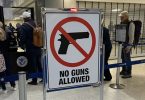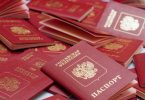New York – Fourteen small white boxes with green glowing screens were installed this week at customs booths around John F. Kennedy International Airport here.
Now, in addition to handing over a passport to Customs and Border Protection agents, every noncitizen visitor has to place all four fingers and thumb from each hand on the glowing screen. Within seconds, CBP has their 10 digital fingerprints on file.
This expanded effort to collect fingerprints of noncitizen visitors is part of a national test of improved biometrics technology that the Department of Homeland Security hopes will make it harder for people with forged documents or criminal pasts to enter the United States. Eventually, they hope to use this technology to ensure that foreign visitors who come leave when their visas have expired.
Estimates are that between one-quarter and one-half of immigrants in the United States arrived with a valid visa, but remained here illegally when it expired and they didn’t leave. The US does little if anything to track them.
The rolling out of this more extensive 10-finger digital print entry technology has raised privacy concerns about how the data will be stored and protected. DHS officials contend there are plenty of privacy protections in place. And they insist the new system will shore up current security efforts because 10-print matches are the most accurate way to identify individuals.
“We’re testing it at multiple locations throughout the US just to get some metrics and practice before we roll it out domestically at all of the ports of entry,” says Robert Mocny, director of the DHS US-VISIT program. “By the end of December 2008 all air, land, and sea ports of entry will have the devices.”
Four years ago, with the memory of 9/11 still fresh, the US started collecting two digital fingerprints and a picture from each noncitizen visitor. As a result, it already has a database of 90 million fingerprints. With this 10-finger digital print technology, it believes it will add 20 million to 23 million fingerprints each year. DHS will keep them in a database for 75 years.
Other countries are also joining the biometric bandwagon. Japan last year began collecting some fingerprints when foreign visitors enter the country and the European Union is considering it. These countries are also talking about sharing these databases That has raised alarms among privacy advocates who worry the data can be accessed or misused.
“Everyone’s data is being stored and disseminated and there are definitely questions about the ability to keep this information secure, as well as whether it will be properly used,” says Melissa Ngo, of the Electronic Privacy Information Center. “We also wonder why exactly there is a need to increasingly grow this database.”
Customs and Border Protection officials insist that data will be securely stored and properly used. They also say keeping these databases will make it easier and more convenient for legitimate travelers by more accurately and efficiently verifying visitors’ identities.
Since its inception in 2004, the current two-print system has snared 2,000 immigration violations, Mr. Mocny told reporters at the JFK event. Sixty percent were criminal violations; 40 percent were civil immigration violations. That has encouraged immigration experts, who are now hoping the system can be adapted for more efficient immigration enforcement against people who overstay their visas.
“US-VISIT has really proven its value for law- enforcement purposes, now we need to extend that to compliance purposes,” says Jessica Vaughan, a senior policy analyst with the Center for Immigration Studies in Washington.
Currently, there are few if any ways to track whether people who arrive on a legal visit leave when their visas expire. For years, overstaying a visa was a fairly easy way to enter the US and stay illegally. After the 1993 World Trade Center bombing, Congress tasked the then-immigration services to track when people leave. But little if anything was done. It’s only been in the last year or so that DHS has seriously begun working on the problem.
“It’s extraordinarily important to have exit tracking,” says Mark Krikorian, director of CIS. “But it’s going to take a little bit of time, political capital and real investments in physical infrastructure at airports and land crossings.”
So DHS decided it would start at the airports. It has already floated the idea of installing similar biometric machines at airport check-in counters and requiring ticket agents to collect fingerprints from foreign visitors when they leave. But the airlines have balked.
David Castelveter of the Air Transport Association, which represents the nation’s major carriers, says that’s because airlines now encourage people to check in online or at automated kiosks. But Mr. Castelveter says they’re willing to work with DHS.
“We certainly don’t have the answer yet,” says US-VISIT’s Mocny. “We’re going to need the airlines’ and the airports’ cooperation and we need to hear from them and understand what their operations are.”
csmonitor.com






















